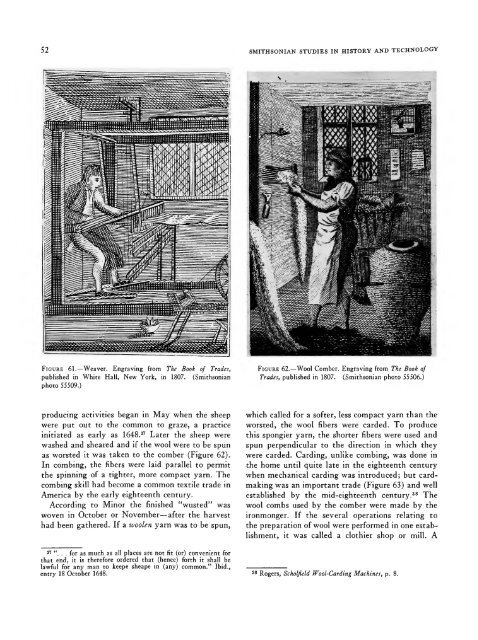The Copp Family Textiles - Smithsonian Institution Libraries
The Copp Family Textiles - Smithsonian Institution Libraries
The Copp Family Textiles - Smithsonian Institution Libraries
You also want an ePaper? Increase the reach of your titles
YUMPU automatically turns print PDFs into web optimized ePapers that Google loves.
52 SMITHSONIAN STUDIES IN HISTORY AND TECHNOLOGY<br />
FIGURE 61.—Weaver. Engraving from <strong>The</strong> Book of Trades,<br />
published in White Hall, New York, in 1807. (<strong>Smithsonian</strong><br />
photo 55509.)<br />
producing activities began in May when the sheep<br />
were put out to the common to graze, a practice<br />
initiated as early as 1648. w Later the sheep were<br />
washed and sheared and if the wool were to be spun<br />
as worsted it was taken to the comber (Figure 62).<br />
In combing, the fibers were laid parallel to permit<br />
the spinning of a tighter, more compact yarn. <strong>The</strong><br />
combing skill had become a common textile trade in<br />
America by the early eighteenth century.<br />
According to Minor the finished "wusted" was<br />
woven in October or November—after the harvest<br />
had been gathered. If a woolen yarn was to be spun,<br />
37 ". . . for as much as all places are not fit (or) convenient for<br />
that end, it is therefore ordered that (hence) forth it shall be<br />
lawful for any man to keepe sheape in (any) common." Ibid.,<br />
entry 18 October 1648.<br />
FIGURE 62.—Wool Comber. Engraving from <strong>The</strong> Book of<br />
Trades, published in 1807. (<strong>Smithsonian</strong> photo 55506.)<br />
which called for a softer, less compact yarn than the<br />
worsted, the wool fibers were carded. To produce<br />
this spongier yarn, the shorter fibers were used and<br />
spun perpendicular to the direction in which they<br />
were carded. Carding, unlike combing, was done in<br />
the home until quite late in the eighteenth century<br />
when mechanical carding was introduced; but cardmaking<br />
was an important trade (Figure 63) and well<br />
established by the mid-eighteenth century. 38 <strong>The</strong><br />
wool combs used by the comber were made by the<br />
ironmonger. If the several operations relating to<br />
the preparation of wool were performed in one establishment,<br />
it was called a clothier shop or mill. A<br />
38 Rogers, Scholfield Wool-Carding Machines, p. 8.

















